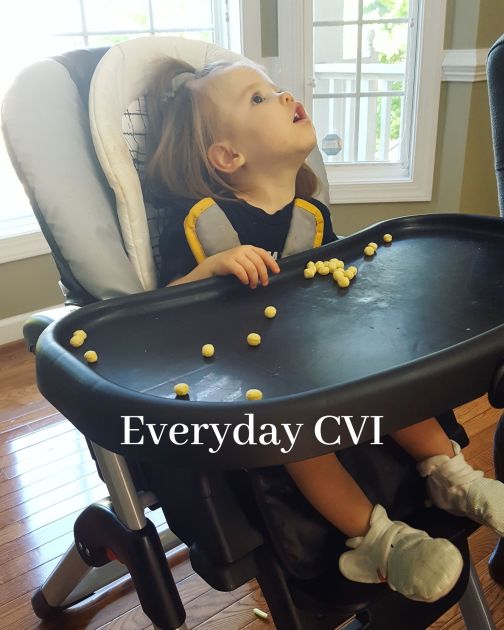This was originally published on the Everyday CVI Facebook page, but I’ve decided to give it a permanent home here on the blog as well. May it serve to encourage you on your CVI journey and/or help raise awareness about everyday life with CVI.
“But she seems to be doing great.”
“What? She doesn’t look like she has special needs.”
“She doesn’t look blind.”
“Why would she ever need a cane?”
“I don’t understand; can she see? It looks like she does.”
—
These are things family, friends, and strangers have said about my daughter that has Cortical Visual Impairment (CVI). It’s beyond frustrating for me to listen to other people comment on things they know nothing about – but that’s the thing: THEY KNOW NOTHING ABOUT IT.
We don’t owe the world explanations, but when I can shed some light on my daughter’s CVI in a constructive way it makes the world around us just a little bit more enlightened, more aware, and potentially even more inclusive. So while the focus of EverydayCVI.com is to share helpful tips and strategies that provide my daughter the visual access to improve her functional vision, today I’m sharing something a little different. It’s a glimpse into our world – not of our visual adaptations, but of what CVI sometimes looks like for our family.
YES, because it is brain-based, Cortical Visual Impairment CAN improve as the plasticity of the brain makes new connections. 🙌 NO, there is no “cure” for CVI. It does not “go away.” Individuals can learn to function (visually) BETTER as their brains learn to resolve the 10 characteristics of CVI, but they will always have this disability of visual access.

Case in point: this photo is of my daughter listening to music after she finished breakfast and I quickly unloaded the dishwasher. Moments before she had been visually engaged with me, her meal, and everything close to her. But as soon as I turned on an upbeat song she had never heard before…THIS.
She is gazing at the ceiling light fixture and has transformed her posture because she is directing her mental energy toward LISTENING. One of the 10 CVI characteristics is “attention to light” or “light-gazing” – because when the world around you appears to be a blur of confusion, lights stand out. My daughter “resolved” this characteristic several months ago, in the sense that she does not *need* light to visually focus on objects – and environmental lighting does not distract her visual focus. Yet here she is.
In this scenario, she was already tired (having woken up too early) and it became mentally challenging to engage her auditory and visual senses together. Since the need to understand the auditory input was stronger than the need to use her vision, she essentially made it easier for her brain to process by expending very little energy on vision. Lights are easy to gaze at in a complex sensory environment that is suddenly demanding she use her other senses.
Does she “look” blind now??
This is life for someone with CVI. An individual in the higher-functioning phases of this vision impairment can, at times, function with “near normal” vision – but can still transition to suddenly feeling and acting blind in a matter of seconds, depending on what kind of environment they are in (and whether or not it is conducive to accessing functional vision).
I do not claim to be an expert on Cortical Visual Impairment, but I AM an expert on my daughter and how CVI impacts every aspect of her daily life. So please, feel free to ask me questions! But like any parent, I also encourage you to resist the urge to *comment* on my daughter or assess her needs based on a SNAPSHOT of a GLIMPSE you’ve gotten of our lives.
#CVI #CorticalVisualImpairment #EverydayCVI #CVI10characteristics #neuroplasticity #VisualAccess #CVIsplaining